|
|
|
Sort Order |
|
|
|
Items / Page
|
|
|
|
|
|
|
| Srl | Item |
| 1 |
ID:
109916
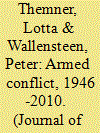

|
|
|
|
|
| Publication |
2011.
|
| Summary/Abstract |
In 2010, UCDP recorded 30 active armed conflicts (i.e. with a minimum of 25 battle-related deaths). This is a substantial reduction in relation to the 36 conflicts registered for 2009. A drop of this magnitude has only been reported four times previously in the post-1946 period. However, only in two of these instances was this part of a general downward trend. Thus no major inferences should be drawn, except perhaps that the reduction in conflicts in Africa seems to be part of a trend. At 30 in 2010, the number of active conflicts is at its lowest level since 2003. Furthermore, the number of wars (1,000 or more battle-related deaths) declined from six in 2009 to four in 2010. The most intense war in terms of fatalities was in Afghanistan. Eight of the armed conflicts listed for 2009 were not active in 2010, but during the year two new conflicts erupted - Mauritania and Tajikistan - both involving rebel groups that had previously fought in neighbouring countries. Only two peace agreements were concluded during the year. While this is one more than 2009, it is decidedly below the annual average for the post-Cold War period.
|
|
|
|
|
|
|
|
|
|
|
|
|
|
|
|
| 2 |
ID:
109914


|
|
|
|
|
| Publication |
2011.
|
| Summary/Abstract |
There is an increasing number of analyses of the effects of terrorism, especially its impact on public opinion. Most of these analyses are focused on the effects of terrorist strategies and attacks on public opinion in general. This article analyzes an important but usually neglected question in this literature: the effects of terrorist strategies on the vote for parties that support the terrorist organization. It uses data referred to the case of the Basque terrorist group ETA and its attached political movement. ETA is one of the most enduring terrorist groups in the world, and during the last three decades, its strategy has combined violence with the convening of truces. The article shows how terrorist strategies, especially the convening of truces and negotiating with the government, significantly increase public support for the terrorist organization. Once the terrorist group has declared a truce and negotiations with the government are under way, the terrorists' constituency has an incentive to increase its mobilization in favour of the terrorist group. With higher levels of support, the terrorist group has a stronger bargaining position, and, therefore, it becomes more likely to attain its demands.
|
|
|
|
|
|
|
|
|
|
|
|
|
|
|
|
| 3 |
ID:
109913
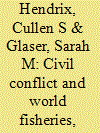

|
|
|
|
|
| Publication |
2011.
|
| Summary/Abstract |
While the negative economic consequences of civil conflict are well known, does civil conflict have sector-specific effects that threaten food and economic security? This article surveys the effects of civil conflict on reported marine and inland fish catch, focusing on the effects of conflict through redeployment of labor, population displacement, counter-insurgency strategy and tactics, and third-party encroachment into territorial waters. Analysis of 123 countries from 1952 to 2004 demonstrates a strong, statistically robust and negative relationship between civil conflict and fisheries, with civil wars (1000+ battle deaths) depressing catch by over 16% relative to prewar levels. The magnitude of this effect is large: the cumulative contraction in total fish catch associated with civil war onset is roughly 13 times larger than the estimated effect of an extraordinarily strong El Niño, the ocean-atmosphere phenomenon associated with global declines in fisheries. Robust evidence of a Phoenix effect is lacking: post-conflict fisheries do not quickly bounce back to prewar catch levels due to more rapid growth. Analysis of conflict episodes indicates that conflict intensity, measured by battle deaths, negatively affects fish catch, while population displacement and conflict proximity to the coast do not. While these findings contribute to the growing literature on the economic effects of civil conflict, they also are important for regional fisheries management organizations, which must increasingly pay attention to sociopolitical factors that dramatically affect the utilization of aquatic resources.
|
|
|
|
|
|
|
|
|
|
|
|
|
|
|
|
| 4 |
ID:
109910
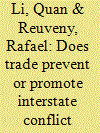

|
|
|
|
|
| Publication |
2011.
|
| Summary/Abstract |
Competing theories argue, respectively, that more trade reduces, increases, or does not affect interstate military conflict. We offer a new general theory on how trade affects conflict, which encompasses the liberal logic and the neo-Marxist/neo-mercantilist mechanism of asymmetric dependence and offers alternative explanations to the effects predicted by the bargaining and classical realist approaches. If a country expects its conflict toward a target to reduce the price of its import from or increase the price of its export to a target, it has an economic incentive to initiate conflict, and vice versa. These expectations can vary across trade flow directions and economic sectors. Using our model, we predict the effects of increases in exports and imports in five sectors on military conflict initiation. Statistical analysis of directed dyads from 1970 to 1997 largely supports our predictions. Rises in the initiator's imports of agriculture/fishery, energy, and chemical/mineral goods and exports of miscellaneous consumption goods reduce the likelihood of conflict initiation; rises in the initiator's exports of energy and both imports and exports of manufactured goods increase the likelihood. We evaluate implications for the literature and public policy.
|
|
|
|
|
|
|
|
|
|
|
|
|
|
|
|
| 5 |
ID:
109909
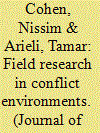

|
|
|
|
|
| Publication |
2011.
|
| Summary/Abstract |
Conducting research in conflict environments is a challenge, given their complexity and common attitudes of distrust and suspicion. Yet, conflict and methodology are usually analyzed as separate fields of interest. Methodological aspects of field work in conflict environments have not been systematically analyzed. This article addresses the central methodological problems of research conducted in conflict environments. We suggest the use of the snowball sampling method (hereafter, SSM) as an answer to these challenges. The effectiveness of this method has been recognized as significant in a variety of cases, mainly regarding marginalized populations. We claim that in conflict environments, the entire population is marginalized to some degree, making it 'hidden' from and 'hard to reach' for the outsider researcher. The marginalization explains why it is difficult to locate, access and enlist the cooperation of the research populations, which in a non-conflict context would not have been difficult to do. SSM directly addresses the fears and mistrust common to the conflict environment and increases the likelihood of trusting the researcher by introduction through a trusted social network. We demonstrate how careful use of SSM as a 'second best' but still valuable methodology can help generate cooperation. Therefore, the evaluation of SSM, its advantages and limitations in implementation in conflict environments can be an important contribution to the methodological training of researchers. In addition to its effectiveness under conditions of conflict, SSM may, in some cases, actually make the difference between research conducted under constrained conditions and research not conducted at all. Together with our experiences in the field, we supply several insights and recommendations for optimizing the use of SSM in a conflict environment.
|
|
|
|
|
|
|
|
|
|
|
|
|
|
|
|
| 6 |
ID:
109911
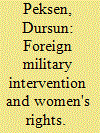

|
|
|
|
|
| Publication |
2011.
|
| Summary/Abstract |
A large body of scholarly work has been devoted to the possible consequences of foreign military intervention for the target state. This literature, however, tends to be state-centric and mostly neglects the insight from gender-specific theoretical and empirical perspectives. The purpose of this article is to examine the extent to which military intervention affects women's rights. It is argued that unilateral interventions are prone to diminishing women's status by encouraging the persistence or creation of repressive regimes and contributing to political disorder in the target state. If the use of armed forces ever helps or causes no damage to women's well-being, it will likely be during interventions led by intergovernmental organizations (IGOs). This is because IGO interventions are unlikely to protect or support an authoritarian, patriarchal political system. Furthermore, such multilateral missions will increase international awareness of women's status along with other human rights issues in the target society, thereby creating more pressure on the government to enforce women's rights. To empirically substantiate these arguments, three different indicators that tap socio-economic and political aspects of women's status are used, including the indices of women's economic, political, and social rights from the Cingranelli-Richards database. The results indicate that while women's political and economic status suffer most during unilateral US interventions, IGO interventions are likely to have a positive influence on women's political rights. Non-US unilateral interventions, on the other hand, are unlikely to cause any major change in women's status. Finally, military interventions in general have no major statistically significant impact on women's social rights.
|
|
|
|
|
|
|
|
|
|
|
|
|
|
|
|
| 7 |
ID:
109917


|
|
|
|
|
| Publication |
2011.
|
| Summary/Abstract |
This article summarizes the results of a recently completed, comprehensive coding of 779 human rights instruments from 1863 to 2003. As such, it offers an extensive portrayal of how, and to what degree, this powerful doctrine has been formally institutionalized over time. Following a brief overview of the data collection process, selected results from this study are presented that highlight how many human rights instruments have been drafted, what kind of violations have been most prominent, the number of rights that have been specified over time, and the ultimate aspirations that are linked to the realization of human rights. Next, potential applications of this dataset are discussed regarding both human rights and peace research scholarship. Specifically, the results shed new light on the historical development of human rights by highlighting key periods of instrument growth in the late 19th century, the interwar years, and the post-World War II period. In addition, the data can effectively augment recent quantitative studies that measure the effect of treaty ratification on internal state violence by helping to generate more extensive ratification information, develop better measures of state compliance, and construct new measures that assess how human rights principles get translated into national practice and potentially mitigate state violence over time.
|
|
|
|
|
|
|
|
|
|
|
|
|
|
|
|
| 8 |
ID:
109912


|
|
|
|
|
| Publication |
2011.
|
| Summary/Abstract |
Previous research, applying perfect deterrence theory, has demonstrated that national missile defense generally enhances the stability of deterrence, primarily because it makes the defender's retaliatory threat more credible. However, stability is not ensured, because missile defense has the potential to increase other states' dissatisfaction with the status quo. Consequently, dissatisfied states have an increased incentive to challenge the status quo, undermining deterrence stability. Although there is a lengthy literature debating this point, no one has conducted a rigorous empirical analysis of the impact of national missile defense on satisfaction. To address this significant gap in the literature, we analyze the impact of US missile defense programs on other states' status quo evaluations through analyses of events data, 1985-2004, and UN voting data, 1985-2008.
|
|
|
|
|
|
|
|
|
|
|
|
|
|
|
|
| 9 |
ID:
109915


|
|
|
|
|
| Publication |
2011.
|
| Summary/Abstract |
The societal security theory posits that extreme anti-migrant hostility - such as demands to deport all migrants unconditionally - emerges when host communities see migration as a threat to the survival of their group identity. An alternative interpretation - the immigration security dilemma - attributes extreme hostility to the human tendency to prepare for the worst under uncertainty when central authority weakens. Does extreme intergroup hostility relate more to threats framed in terms of group survival or to those framed in terms of uncertainty about government capacity and migration effects? I investigate this question empirically with the Russian national survey data (2005, N = 680) asking who in Russia supports the deportation of all internal and external migrants, legal and illegal, and their children to their places of origin - an extreme and widespread view that would require forced population movements not seen in the region since Stalin's Great Terror. In multivariate tests, agreement with the societal security (survival) rhetoric explained about five percent of variation in support for unconditional, wholesale deportation of migrants; agreement with the security dilemma (uncertainty) rhetoric - about 20%. A comparison of attitudes in the same survey to Armenian, Uzbek, Chechen, and Chinese migrants and the association of each ethnic group with different types of security threat further support this finding. Hostility toward ethnic groups viewed as a weak security threat was more diagnostic of public support for wholesale deportation of migrants than hostility toward groups viewed as a strong security threat.
|
|
|
|
|
|
|
|
|
|
|
|
|
|
|
|
| 10 |
ID:
109918


|
|
|
|
|
| Publication |
2011.
|
| Summary/Abstract |
The Stockholm International Peace Research Institute (SIPRI) and the International Institute of Strategic Studies (IISS) both publish datasets on military expenditure that are widely used by scholars and military analysts. This article illustrates the limitations in the reliability and validity of these data, using a case study of contemporary Venezuela to highlight the issues. There is a debate over recent Venezuelan military expenditure under President Chávez: some argue that the expenditure has increased dramatically; others argue that it has not. The SIPRI and IISS datasets ought to be tailor-made for resolving this debate, but the estimates they provide are significantly flawed: military spending is reported to be quite low and to have declined as a percentage of GDP. New evidence presented in this article suggests that Venezuela's recent military expenditures were typically at least 20% to 70% higher than the estimates provided by SIPRI and IISS. Moreover, the military expenditures have at least kept pace with GDP growth as oil revenues increased over the period 2002-08. A key source of the discrepancy in the estimates is the way in which extra-budgetary purchases, especially of foreign arms and supplies, are treated. In some states, such as Venezuela in recent years, extra-budgetary purchases are responsible for a large portion of the expenditure, but these purchases are frequently not captured by standard data sources.
|
|
|
|
|
|
|
|
|
|
|
|
|
|
|
|
|
|
|
|
|